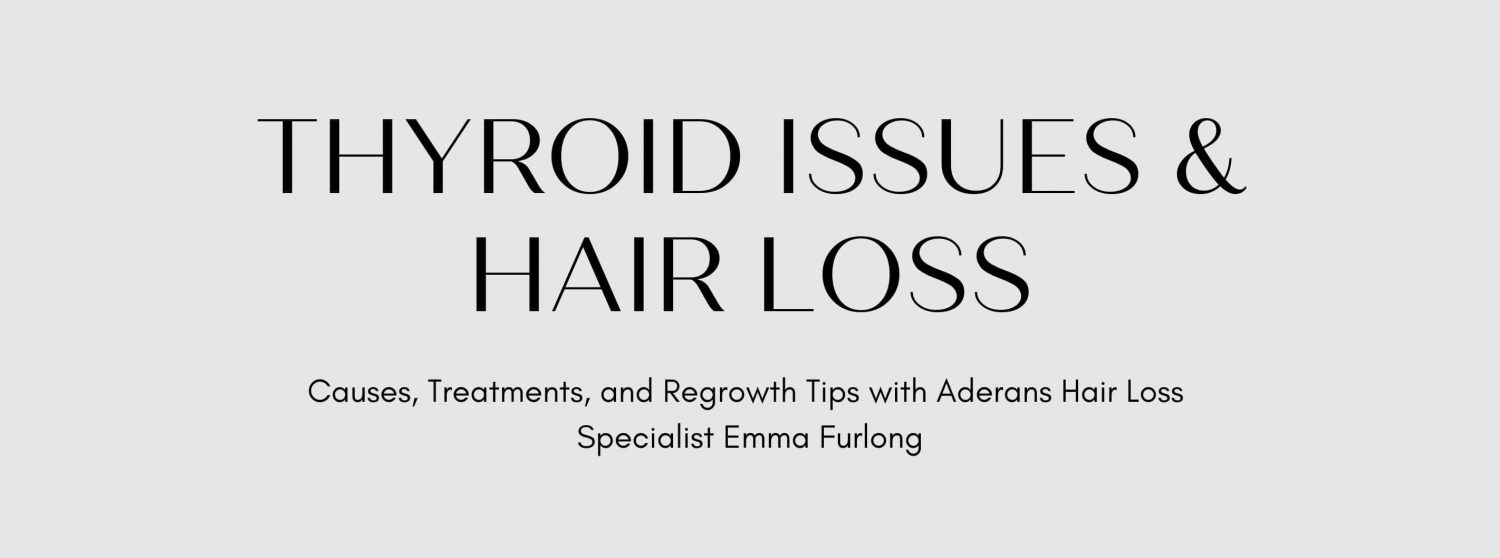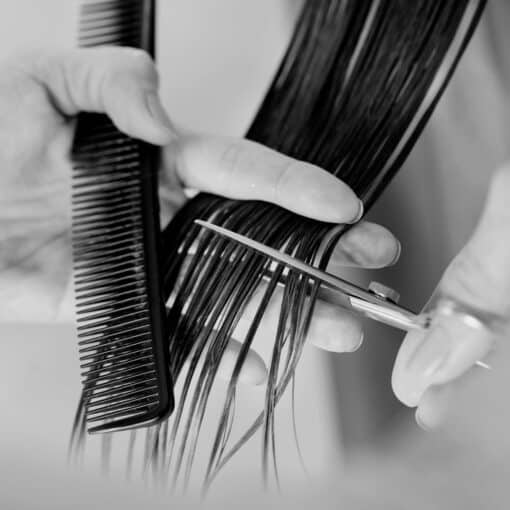
Hair loss on any level can be a distressing experience, and for many people, thyroid issues are a hidden culprit. The thyroid gland plays a crucial role in regulating hormones that influence hair growth. When thyroid function is disrupted, it can lead to excessive hair shedding and thinning. It is unusual for hair loss to be the only symptom of thyroid issues, but it can sometimes be the reason people seek help and advice. In this blog, we’ll explore how thyroid issues cause hair loss and the best ways to treat and manage it.
How Thyroid Issues Cause Hair Loss
The hair growth cycle consists of three phases:
Anagen (growth phase)
Catagen (transition phase)
Telogen (resting/shedding phase)
Thyroid imbalances can push more hair into the telogen phase, causing diffuse hair loss (thinning hair), also known as telogen effluvium.
With severe and prolonged hypothyroidism and hyperthyroidism, the hair growth hormones are redirected in the body’s attempt to address the imbalance. The loss is usually of the diffuse variety and involves the entire scalp rather than discrete areas, becoming noticeable when the hair appears uniformly sparse. On the positive side, hair loss will stabilise and regrow with successful treatment of the thyroid disorder, though it may take several months and, in some cases, may be incomplete. It is unusual for mild hypothyroidism, hyperthyroidism, or short-lived thyroid problems to cause noticeable hair loss.
Here’s how different thyroid conditions contribute to hair loss:
Hypothyroidism (Underactive Thyroid)
An underactive thyroid slows down metabolism and cell regeneration, leading to:
- Thinning hair, particularly on the scalp and eyebrows
- Brittle, dry hair
- Loss of eyebrow hair (especially the outer third, known as the “Queen Anne’s Sign”)
Hyperthyroidism (Overactive Thyroid)
An overactive thyroid speeds up metabolism and can result in:
- Increased hair shedding over the whole scalp
- Fine, limp, and thinning hair
Autoimmune Thyroid Disease (Hashimoto’s & Graves’ Disease)

These conditions can trigger alopecia areata, leading to patchy hair loss. Autoimmune diseases attack hair follicles and disrupt growth cycles.
If a person has one autoimmune disease, he/she is more likely than others to develop other autoimmune conditions. Alopecia areata is an autoimmune condition that causes hair loss that occurs in people with autoimmune thyroid disease more often than expected by chance. Unlike the types of diffuse hair loss (thinning) described above, alopecia areata causes discrete, often circular, areas of hair loss. In most cases, this is transient and does not progress, but unfortunately, it can cause significant hair loss.
Nutritional Deficiencies & Thyroid Hair Loss
Thyroid dysfunction can lead to deficiencies in:
- Iron & Ferritin (critical for hair growth)
- Zinc & Selenium (essential for thyroid function and hair health)
- Vitamin D & B12 (low levels contribute to hair thinning)
Treatment-Related Hair Loss

Some thyroid medications, like levothyroxine, may cause temporary hair shedding as the body adjusts to hormone levels. This typically stabilises over time.
In rare cases anti-thyroid drugs (carbimazole and propylthiouracil) can cause diffuse hair loss. It may be very difficult to tell whether the hair loss is due to the effects of the previous overactivity of the thyroid or the anti-thyroid drugs. In all probability, the anti-thyroid drugs are not the cause and it is unusual to have to seek alternative treatment for hyperthyroidism. Monitoring and advice with a trichologist can help ascertain the cause of the hair loss.
Effective Treatments for Thyroid-Related Hair Loss
If thyroid imbalance is the root cause of your hair loss, addressing it directly is the most effective solution. Here’s how:
Balance Your Thyroid Hormones
For Hypothyroidism: Medications like levothyroxine help restore normal thyroid function. Supporting diet: iodine-rich foods (seaweed, dairy, eggs), selenium-rich foods (Brazil nuts, fish).
For Hyperthyroidism: Anti-thyroid drugs (Methimazole, Propylthiouracil) regulate hormone levels. Severe cases may require radioactive iodine therapy or thyroid surgery.
For Autoimmune Thyroid Disease: Managing inflammation with an anti-inflammatory or gluten-free diet may help those with Hashimoto’s thyroiditis.
Address Nutritional Deficiencies
Incorporate foods or supplements rich in:
- Iron & Ferritin (lean meats, spinach, legumes)
- Zinc & Selenium (seafood, nuts, seeds)
- Vitamin D & B12 (fatty fish, dairy, fortified foods)
- Biotin (Vitamin B7) (eggs, nuts, whole grains)
Use Gentle Hair Care Products
Thyroid-related hair loss makes hair brittle and prone to breakage. To combat this, you could use:
- Low sulfate/nourishing shampoos
- Hydrating conditioners with hair-friendly oils such as keratin or argan
- Stimulatory regrowth products such as Minoxidil (Rogaine) (consult a hair loss specialist before use)
Consider Hair Growth Treatments
- Low-Level Laser Therapy (LLLT): Stimulates hair follicles
- Scalp Microneedling: Increases blood flow to hair roots
Alternative Hair Solutions for advanced/prolonged loss
Partial hair pieces and wigs can offer an instant solution to noticeable hair loss, with a wide range of options available. A consultation with a wig specialist is always worth considering. CONTACT US HERE
Manage Stress & Lifestyle Factors
- Exercise regularly to boost circulation and hormone balance
- Practice relaxation techniques like meditation, walking or reading to lower cortisol (stress hormone)
- Get sufficient sleep to support overall health and hair regrowth
How Long Does It Take to See Hair Regrowth?

Once thyroid levels are stabilized, hair regrowth typically starts within 3-6 months, but it may take 6-12 months before the growth is fully established. Being patient and consistent with treatment is key.
Some forms of hypothyroidism and hyperthyroidism come on abruptly and are diagnosed early, while others may have been present for months or years before diagnosis. Hair loss due to thyroid disease often only becomes apparent months after the onset of thyroid disease. This is due to the long hair cycle mentioned above, and the hairs that have stopped growing are often left ‘resting’ in the follicle, shedding weeks/months later. In some such cases, paradoxically, the shedding may follow the treatment for the thyroid and the thyroid medication may be erroneously blamed, in some cases leading to the withdrawal of treatment, which in turn may worsen the hair loss.
Final Thoughts
Thyroid-related hair loss can be frustrating, but it is often reversible with proper treatment. Balancing your thyroid hormones, addressing nutrient deficiencies, and using supportive hair care and lifestyle changes can help restore healthy hair growth.
If you’re experiencing unexplained hair loss, it’s essential to get your thyroid levels checked (TSH, T3, T4, and thyroid antibodies) to determine if an imbalance is the root cause. It is also worth noting that levels within a ‘normal’ range but at the lower levels may still signal a thyroid imbalance so full screening and assessments are essential.
As ever, if you have any queries on this blog or experiences to share please get in touch, we’re always here to help. BOOK A CONSULTATION HERE



